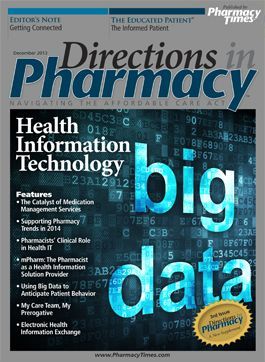Publication
Article
Pharmacy Practice in Focus: Oncology
Electronic Health Information Exchange
Author(s):
The increased emphasis on interoperability and interconnectedness in health care brings challenges and rewards to pharmacists.

The increased emphasis on interoperability and interconnectedness in health care brings challenges and rewards to pharmacists.
Health care is in the midst of its most fundamental shift in more than a half-century, with massive changes via the Affordable Care Act that are driving not only new patients into the system, but new care models, new pressures to bring costs down, and a new emphasis on technology as a panacea.
It’s a constantly changing environment, but one that pharmacists are poised to benefit from greatly, pushed by 2 megatrends: the need to connect the health care system for interoperability and the demand for high-quality and personalized care.
These trends are interwoven. Better health care technology allows pharmacists to spend less time juggling information systems that can’t talk to each other and more time delivering care and counseling, from medication interaction checks to vaccine delivery. Yet any technology, no matter how powerful, that takes the pharmacist away from the patient and away from his or her business, is doomed to fail.
The first element—the need for greater connectivity and better interoperability— is critically important in health care, but is frequently overlooked in an industry that has long been fragmented. Getting medical data in the right hands at the right time remains a challenge, even in the era of the always connected consumer. There remains a need for standardization of platforms that allows different parts of the health care system to securely talk to each other.
It’s a tall order, but not an impossible task. The financial services industry faced the same array of forces over the past 2 decades—a need for security and a fail-safe system to meet consumer demand for interconnectedness—and it delivered a system in which anyone with an ATM card can confidently and instantly access cash anywhere in the world. This automation has meant huge advances in productivity. Very few bankers still chase pieces of paper, and consumers no longer need to scribble in a ledger to keep track of their checking account balance.
As an industry, we need to get to a similar place, where technology becomes ubiquitous. While we still have work to do, the good news is that we’re well on our way. The benefits are clear. When pharmacists and other health care providers can access clinical information when and where they need it, there is a clear drop in medical errors, a clear boost in efficiency, and improved care coordination. Our ongoing focus on quality, security, and privacy will ensure continued growth and success as we tackle new challenges. This brings us to the second megatrend—the need to deliver high-quality care and more personalized medicine.
Connecting Pharmacists
To achieve this, it is critical to connect pharmacists to all aspects of the health care system to allow easy and secure information sharing with providers and payers in order to make more informed care decisions and improve patient outcomes. The mechanism by which this can be accomplished is a nationwide network that enables electronic health information exchange and allows for seamless transmission of care information—including clinical messages and immunization summaries—to practices and health systems locally and nationally, regardless of technology platform.
It’s important that pharmacists—and all health care providers—connect to a network that is trusted and dependable and can address the challenges of connectivity and electronic information exchange. For the past 12 years, Surescripts has been focused on building and establishing standards for a network that connects as many entities across the system as possible. We’ve made interconnectivity between care providers a reality. Today, we move 6 billion transactions each year, and 93% of community pharmacies receive prescriptions electronically. The network now includes a variety of services beyond e-prescribing that align with payment reform, population health, and immunization reporting to help improve care delivery and coordination.
One of the most powerful examples of how connectivity can benefit pharmacists, patients, doctors, and public health officials is the rise of immunization registries. In 2012, nearly 20% of all flu shots were administered in a pharmacy or retail store, according to the Centers for Disease Control and Prevention. With flu shots and other immunizations increasingly becoming a part of the expanded services that pharmacists are delivering in support of quality patient care, the ability of pharmacists to electronically share clinical information with other health care providers and government agencies quickly, efficiently, and securely is crucial.
Where and when someone receives an immunization is critical. It’s helpful to doctors who need to know which patients are protected and who needs further attention, and it’s valuable for public health agencies, many of whom require immunization reporting at the state level. But how to share that data is not trivial: the pharmacist, the doctor, and the public health agency all must be able to access and share the data.
Our immunization-reporting products and services enable automated reporting from pharmacists to state and regional public health registries where there is a mandatory or voluntary reporting requirement. Nationwide pharmacy chains may be required to report immunization information to multiple registries and in various formats and frequencies. Surescripts’ Immunization Registry Reporting product simplifies the process, allowing pharmacists to save time and resources over a manual process, bringing them out from the back office and ensuring that they have more time to spend with patients.
This technology is already being used by some of the largest pharmacy chains in the country. All of the nearly 4600 Rite Aid pharmacies, for example, can send a notification of a patient’s immunizations to the patient’s health care provider in whatever form the provider is able to best receive it, including electronically or via fax or mail.
New Paradigm of Care Delivery
This is a model for a new paradigm of care delivery, where pharmacists are not middlemen in the health care system, but point-of-care providers that offer a range of personalized services that integrate seamlessly and cost effectively with other providers across the continuum of care. Vaccine delivery is a win for everyone involved. Patients can get their flu shot conveniently, doctors can have confidence that the information will appear reliably and securely in their medical records system, and public health officials receive high-priority data seamlessly.
As patient care delivery and consultation through pharmacy and retail clinics expands from prescriptions to vaccinations, health screenings, and beyond, the ability for care information to follow the patient is critical. In this new care dynamic, it is essential that the pharmacy notify health care providers about care delivered to support timely updates and a more complete view of patient records. With that technological infrastructure in place to handle care coordination and patient-focused care delivery, pharmacists are positioned at the center of the health care system, driving positive patient outcomes, lower costs, and a better health care experience for all.
David Yakimischak is executive vice president and general manager of Medication Network Services, Surescripts. His previous roles with Surescripts include leading the Quality Office and serving as chief technology officer. David has 25 years of experience in technology management and product development in the health care, financial, and publishing industries.







